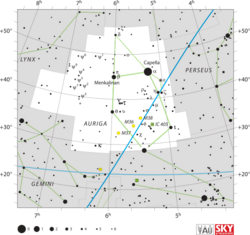Astronomy:Chi Aurigae
| Observation data Equinox J2000.0]] (ICRS) | |
|---|---|
| Constellation | Auriga |
| Right ascension | 05h 32m 43.67312s[1] |
| Declination | +32° 11′ 31.2753″[1] |
| Apparent magnitude (V) | 4.74[2] |
| Characteristics | |
| Spectral type | B5 Iab[3] |
| U−B color index | –0.44[2] |
| B−V color index | +0.32[2] |
| Astrometry | |
| Radial velocity (Rv) | –0.2[4] km/s |
| Proper motion (μ) | RA: –1.52[1] mas/yr Dec.: –4.33[1] mas/yr |
| Distance | 3,000 ly (912[5] pc) |
| Absolute magnitude (MV) | –6.4[5] |
| Orbit[5] | |
| Period (P) | 676.85 ± 0.21 d |
| Eccentricity (e) | 0.116 ± 0.048 |
| Longitude of the node (Ω) | 181.7° ± 24.3° |
| Periastron epoch (T) | 2422754.2 ± 46.1 HJD |
| Semi-amplitude (K1) (primary) | 22.0 ± 2.9 km/s |
| Details | |
| Surface gravity (log g) | 2.5[5] cgs |
| Temperature | 15,500[6] K |
| Rotational velocity (v sin i) | 40[7] km/s |
| Other designations | |
| Database references | |
| SIMBAD | data |
Chi Aurigae, Latinized from χ Aurigae, is the Bayer designation for a binary star system in the northern constellation of Auriga. It is faintly visible to the naked eye with an apparent visual magnitude of 4.74.[2] The annual parallax shift of this object is much smaller than the measurement error, making distance estimates by that means unreliable.[1] The estimated distance to this star is approximately 3,000 light years. The brightness of the star is diminished by 1.26 in magnitude from extinction caused by intervening gas and dust.[5]
Chi Aurigae is a spectroscopic binary with an orbital period of 676.85 d and an eccentricity of 0.12.[9] The primary component of this system is a supergiant star with a stellar classification of B5 Iab.[3] It has a stellar wind that is causing mass loss at the rate of 0.38–0.46 × 10−9 solar masses per year, or the equivalent of the Sun's mass every 2.4 billion years.[6]
References
- ↑ 1.0 1.1 1.2 1.3 1.4 van Leeuwen, Floor (November 2007), "Validation of the new Hipparcos reduction", Astronomy and Astrophysics 474 (2): 653–664, doi:10.1051/0004-6361:20078357, Bibcode: 2007A&A...474..653V. Note: see VizieR catalogue I/311.
- ↑ 2.0 2.1 2.2 2.3 Crawford, D. L.; Barnes, J. V.; Golson, J. C. (1971), "Four-color, H-beta, and UBV photometry for bright B-type stars in the northern hemisphere", The Astronomical Journal 76: 1058, doi:10.1086/111220, Bibcode: 1971AJ.....76.1058C.
- ↑ 3.0 3.1 Lesh, Janet Rountree (December 1968), "The Kinematics of the Gould Belt: an Expanding Group?", Astrophysical Journal Supplement 17: 371, doi:10.1086/190179, Bibcode: 1968ApJS...17..371L.
- ↑ Wilson, Ralph Elmer (1953), "General Catalogue of Stellar Radial Velocities", Carnegie Institute Washington D.C. Publication (Washington: Carnegie Institution of Washington), Bibcode: 1953GCRV..C......0W.
- ↑ 5.0 5.1 5.2 5.3 5.4 Raja, Tomas; Wolf, Marek (March 1998), "Hα variability of the B-type binary chi Aurigae", Astronomy and Astrophysics 331: 550–556, Bibcode: 1998A&A...331..550R.
- ↑ 6.0 6.1 Prinja, R. K.; Massa, D. L. (October 2010), "Signature of wide-spread clumping in B supergiant winds", Astronomy and Astrophysics 521: L55, doi:10.1051/0004-6361/201015252, Bibcode: 2010A&A...521L..55P.
- ↑ Abt, Helmut A.; Levato, Hugo; Grosso, Monica (July 2002), "Rotational Velocities of B Stars", The Astrophysical Journal 573 (1): 359–365, doi:10.1086/340590, Bibcode: 2002ApJ...573..359A.
- ↑ "* chi Aur". SIMBAD. Centre de données astronomiques de Strasbourg. http://simbad.u-strasbg.fr/simbad/sim-basic?Ident=%2A+chi+Aur.
- ↑ Pourbaix, D. et al. (2004), "SB9: The ninth catalogue of spectroscopic binary orbits", Astronomy and Astrophysics 424 (2): 727–732, doi:10.1051/0004-6361:20041213, Bibcode: 2004A&A...424..727P.
External links
 |


